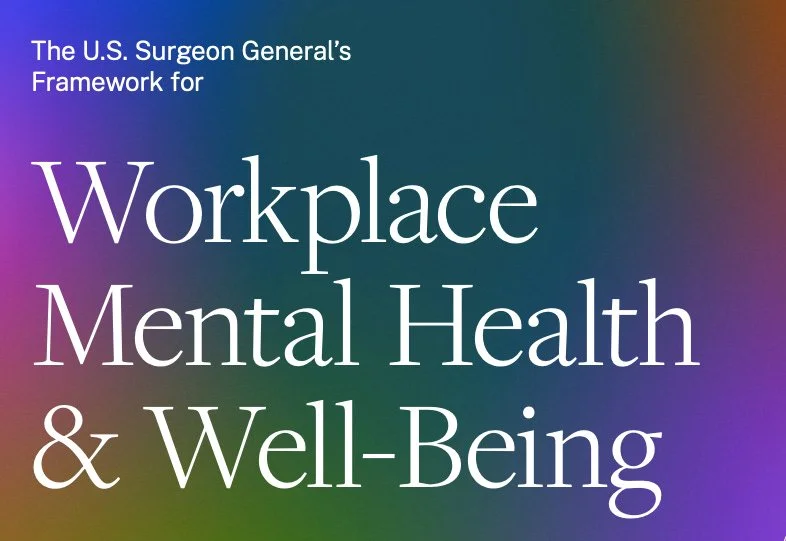How work can boost our wellbeing
According to the surgeon general, author Priya Parker and amazing experience designer Mirit Cohen
At a time when many people are reevaluating their relationship with work and to taking care of themselves, it’s critical to understand the potential that our workday has to boost our wellbeing. Fortunately, I happen to know someone who is an expert on this topic: Mirit Cohen, senior manager of workplace experience programs at Adobe, a client and friend whose brilliance and creativity never cease to wow me. After talking with Mirit about the surgeon general’s recent report on the impact that our workplaces have on our physical and mental health, I asked her to take some time to share her vision for designing for connection at work, including some examples of what this looks like in action. I hope you’ll give it a read and pass it along to your HR team, and/or any senior leaders you know who might have the power to bring this “design for connection” ethos to your workplace.
Get ready to get inspired by the potential we have to create workplace experiences that make life better.
Mirit Cohen headshot
Why we must design for connection at work
By Mirit Cohen
In case there was any question, surgeon general Vivek Murthy recently released a framework outlining the pivotal role that workplaces play in shaping our physical and mental health. I’ve written about Murthy before: In the past he’s talked about the loneliness epidemic this country is facing, and I’ve argued that in a disconnected society, meals at work can bring people together. His more recent statement confirms what those leading in the workplace experience space know, which is that our experience of work isn’t about the perks we do or don’t receive, it’s about our emotional, psychological, and physical wellbeing as humans.
Cover of the U.S. Surgeon General's Framework for Workplace Mental Health & Well-being
Looking at the state of workplace experience through this high-stakes lens, it’s encouraging to see that “Employee Experience Manager” is the fifth fastest-growing job in the U.S, according to LinkedIn research. And it’s not surprising: People are still processing the trauma of the last few years, not to mention all those who are processing the ongoing trauma they experience as people who are not white, heterosexual, cis-gendered, able-bodied, neurotypical men. As Gartner’s readout on future of work trends in 2023 observes,
“Most humans, and that includes current and incoming employees, are still experiencing pervasive mental health challenges as a result of the societal, economic and political turbulence of recent times. This may decrease productivity and performance, as well as increase angry outbursts, no-notice quitting, workplace conflict and sudden underperformance.
Eighty-two percent of employees now say it’s important that their organizations see them as a whole person, rather than simply an employee.”
Consider, too, that, according to the Surgeon General’s report,
76% of U.S. workers reported at least one symptom of a mental health condition.
84% of respondents said their workplace conditions had contributed to at least one mental health challenge.
81% of workers reported that they will be looking for workplaces that support mental health in the future.
It’s easy to conflate meaningful employee experience programs with more lightweight “perks” (as seen in articles such as this one, which talks about health and wellbeing offerings in the same breath as hammocks and free sushi). This creates a risk that when times get tough, the wrong things will get cut, often without recognition of what’s really being lost.
Priya Parker, author of the global bestseller The Art of Gathering, talks about the importance of designing for connection at work:
“Many cultures around the world build collective mechanisms into the workday. I lived in India for three years. In my workplace, as in many, there was a regular afternoon tea break where everyone would hit pause, hang out in the canteen, and drink tea together. In his excellent book Four Thousand Weeks, Oliver Burkeman writes about the Swedish Fika, ‘the daily moment when everyone in a given workplace gets up from their desks to gather for coffee, cake...For half an hour or so, communication and conviviality take precedence over hierarchy and bureaucracy.’ One senior manager told Burkeman that Fika was ‘by far the most effective way to learn what was really going on in his company.’
Note: this is different than putting snacks out in a cafeteria or having free kombucha and hoping for the best. It’s creating a specific moment in which people have the social permission (and yes, the social pressure) to come together at the same time and the same place and hang. Sure, it can be problematic if not done well. That’s where the testing and designing and thoughtfulness comes in.”
People gathered around a table having coffee
As Parker illustrates, hospitality at work, when done right, brings people together in meaningful ways that ultimately serve the business. And doing hospitality at work “right” means starting with purpose and designing from there, rather than simply copying what others are doing; it means starting with “why,” instead of “what.”
As just one example of starting with “why,” I’ve been thinking a lot about how to meet the needs of a population that’s most at-risk for social isolation at work: new hires. While there is no dearth of opportunities to connect and build community at any company that, like mine, cares about culture, access to it can be opaque and/or overwhelming. Simply overcoming social anxiety to start a conversation with someone new or finding the most compelling, personally relevant, opportunities to connect can be difficult and demoralizing. So we’re experimenting with a variety of ways to amplify new connections. One is our experimentation with the design of a table-top object — the “Join Me” signal — that provides the social nudge you might need to meet someone new. We’re also exploring how we might deliver personally relevant recommendations for events to attend and communities / clubs to join so you can “find your people” faster (stay tuned).
The best workplace experience designers bring to life experiences — from meals to meetings, festivals to fireside chats — that amplify purpose, strengthen culture, and treat human beings well. Before cutting any aspect of your employee experience, be sure you’re clear-eyed about the full impact of the gap you’re creating since, as the Surgeon General’s report makes extremely clear, that gap has very human consequences. Engage experience designers in creating an alternative solution that offers value, rather than a gaping hole.



